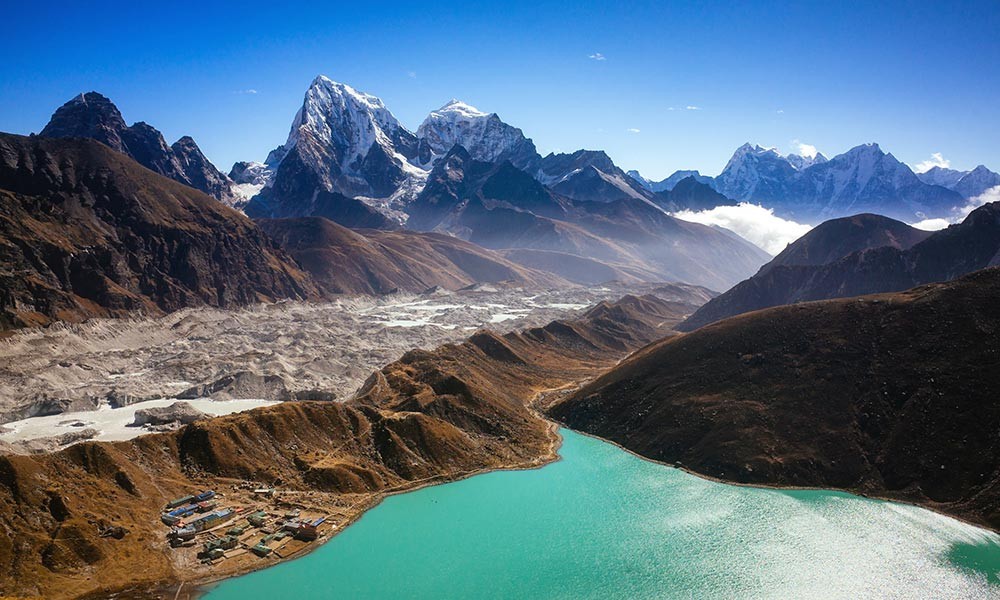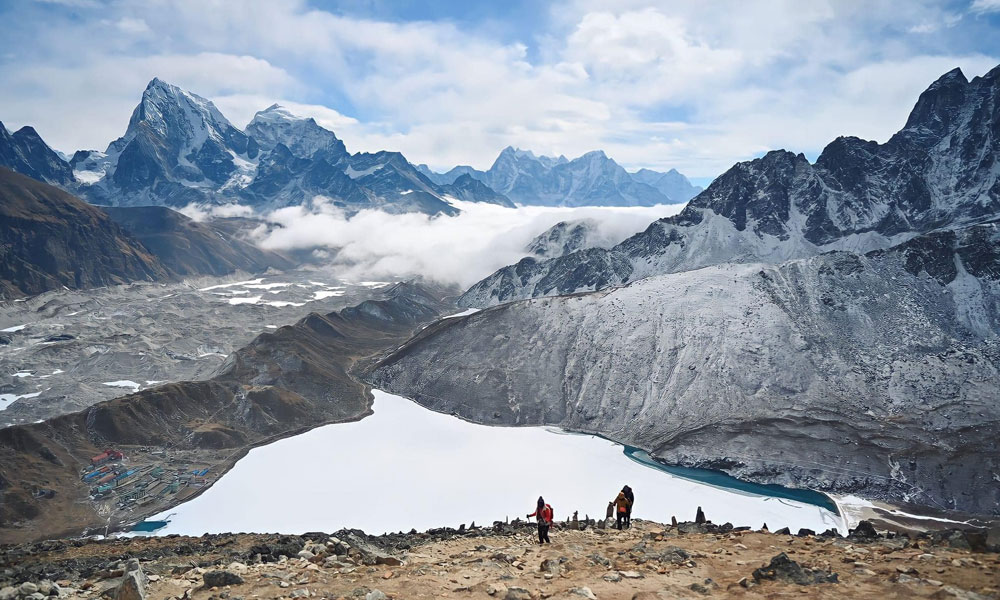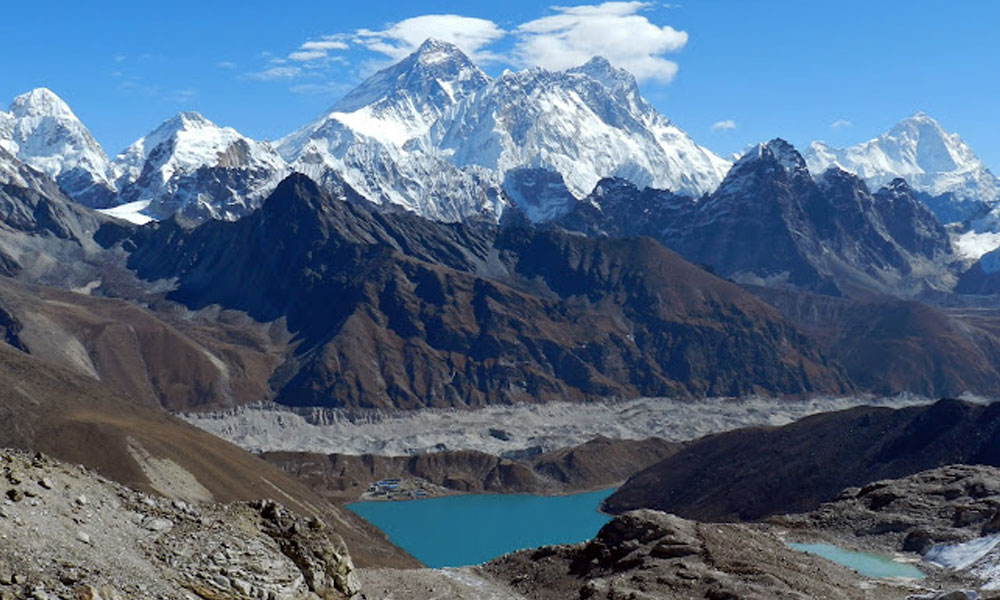
Gokyo Lake Trek offers a unique perspective to explore the unparalleled beauty of the Everest region. This trek offers an exceptional alternative to the traditional Everest base camp trek and is also a great way to experience the striking scenery of the Khumbu region. The journey's highlight is the serene, azure freshwater lakes situated amidst towering snow-capped mountains.
Gokyo Valley is beautiful all year around, offering you rewarding visits regardless of season. The series of six Glacial Gokyo Lakes, Gokyo Cho (Dudh Pokhari), Thonak Cho, Gyazumpa Cho, Tanjung Cho, Ngojumba Cho, and Kyajumba Cho exhibits a unique and different charm, captivating the heart of individuals to attempt for Gokyo lake trek.
Now, you may wonder what is the best time for the Gokyo Lake trek. For the best value experience, trekkers prefer to embark on the foot of the Himalayas, mainly in the spring and autumn seasons. You may have a query about visiting the Gokyo Valley during the other two seasons.
So, this blog will give you a little breakdown of each month and describe how each month will reward your trek and what difficult factors you will be overcoming in your journey.
Which Is The Best Time For Gokyo Lake Trek?
The beauty of the turquoise lakes is magnified by the ethereal surroundings of clear and crisp mountain views, mostly during the peak season of spring and autumn. However, this does not imply that visiting Gokyo Lake in the off-season of summer and winter would be wasteful. During these seasons. you will get to witness the ever-changing panorama of the Everest region, but getting there will come with challenges due to the weather and complexity of the trek.
Gokyo Lake Trek In Spring Season

No one knows what heaven or paradise looks like. But it must somewhat resemble the ambiance of Gokyo Lake when the spring is in full swing. The Gokyo Lake trail's splendor will be seen after nature awakens from its lengthy winter hibernation and sheds its heavy covering of snow. From March to May, the temperature of the Khumbu region will start to rise gradually with longer hours of sunlight during the day. Additionally, the frozen Gokyo Lake will begin to thaw and return to its original state of stagnant water.
Furthermore, the lower trail section of the Gokyo Lake trek will dance to the rhythm of spring. Rhododendron blossoms in various tints scattered throughout the verdant woodland create a striking contrast to the vista of the snow-capped mountains. The growling sound from awakened fauna after winter hibernation adds more melody to your Gokyo Lake trek.
Gokyo Lake Trek In March
March welcomes the spring season in the Gokyo Valley. Even though the bitterly cold winter is gone, the remnants of winter still hold a strong grip over the Everest region during the first weeks of March. However, as the month progresses, the temperature will start to rise gradually, hovering between 1 degree Celsius to 8 degrees Celsius at the end of March. The morning and night temperatures will be chilly, dropping to -12 degrees Celsius at higher elevations
However, with about 8.9 hours of sunlight during the daytime, the weather will be pleasant and stable, providing an ideal trekking environment. The landscapes will still be covered with snow during March, which adds a more dramatic effect to your Gokyo Lake trek. Moreover, you will need to use an ice axe, ropes, and crampons to overcome some of the snowy sections during your day.
Gokyo Lake Trek In April
As the spring progresses to April, the weather will become much warmer, with temperatures averaging around 7 degrees Celsius to 10 degrees Celsius in the Khumbu region. The days will start to linger longer with more than 9 hours of sunlight, giving ample opportunity for exploration.
The trails will be carpeted with the petals of colorful wildflowers like orchids and primroses. At the same time, forests are thick with greenery. The red, pink, and purple blossoms of rhododendrons on top of those green canopy rhododendron trees add color in April. With a clear sky, you can have a view of snow-capped mountains from every perspective during April.
You can even interact with the mountaineers who are attempting to conquer the summit of mighty Mount Everest during April at the trails of the Gokyo Lake trek. No wonder April is considered to be one of the best times for the Gokyo Lakes trek.
Gokyo Lake Trek In May
May falls right at the end of spring. During May, the Everest region receives about 9 hours of sunshine during the day, which makes the trail of the Gokyo Lake dry. The temperature will range between 10 degrees Celsius to 15 degrees Celsius, providing stable weather for the trek. In addition, rhododendrons will be in full bloom throughout this month. The frozen waterfalls and rivers will start to melt, adding more current to their flow.
However, with the monsoon approaching in the Gokyo Valley, the last few weeks can experience some significant weather changes. The lower region of the Khumbu Valley can get some pre-monsoonal rainfall, which can make the trails wet and slippery. Hence, necessary preparations for the precipitation should be made if you are embarking on the Gokyo trek at the end of May.
Gokyo Lake Trek In The Monsoon Season

The monsoon season in Nepal lasts through June, July, and August. Trekking in monsoon season is notorious for muddy and slippery trails, landslide-prone landscapes, frequent downpours, and rife leech problems. Even though the high elevation of the Everest region may not have frequent downpours, the mountains will be enveloped with thick clouds and fog, which creates obstructions to witnessing the mountains.
Moreover, with the rainy season comes the lush vegetation. The forest will be filled with mosses, ferns, and other vegetation that thrives in a damp atmosphere. Additionally, small streams will be gushing out into big rivers during the monsoon season.
Gokyo Lake Trek In June
With the arrival of June, the temperature will start to rise up to 16 degrees Celsius in the Everest region. The weather will be hot, with an average of 11 hours of sunshine. The first half of June will have little to no rain however, with the second half of June, you can experience the drizzle of rainfall but not a downpour. With the frequency of rainfall in the last weeks of May, the temperature can drop down to around -1 degree Celsius in the Gokyo Valley.
Gokyo Lake Trek In July
July is the major monsoon month, with temperature and humidity high. The temperature will range between 12 degrees Celsius to 16 degrees Celsius during the daytime at higher altitudes. Likewise, the Everest region's average nighttime temperature will drop to 2 degrees Celsius. Moreover, the trails of the Gokyo Lake trek, passing through verdant meadows, dense forests, and pasturelands, will be decorated with vibrant vegetation. At the same time, the rivers and streams will be flowing vigorously as heavy rainfall adds more current to the water flow.
Gokyo Lake Trek In August
August falls right at the end of the monsoon when autumn is approaching the Everest region. You can expect bright sunshine with temperatures ranging between 12 degrees Celsius to 16 degrees Celsius. Moreover, the air will be very humid this season, resulting in more clouds and haze in the sky.
In August, numerous individuals trek to Gokyo Lake despite adverse weather. This journey has a more religious purpose. Nag Devata is believed to reside in the Gokyo Lake. In addition, the Shiva and Vishnu temple is located on the lake's western shore. Around 500 Hindu pilgrims go on the challenging Gokyo Lake trek every year to immerse themselves in the holy waters during the August festival of Janai Purnima. It is believed that this ritualistic bathing will bestow Moksha, or freedom, to humans.
Gokyo Lake Trek In Autumn Season

Here comes another peak season for immersing in the beauty of the Everest region via Gokyo Lake. Spanning from September to November, the autumn season fills the trails of Gokyo Lake with trekkers through its pleasant weather and dry terrain. With low humidity in the air, skies are usually clear, allowing you an expansive view of the Himalayan vistas.
Moreover, autumn is considered a harvest season. So, while making your way to the Gokyo Valley, you can discover farmers harvesting crops like buckwheat, barley, etc. At the same time, the fall foliage displaying the orange, red, and yellow colors adds a different layer of visual feast while trekking.
Gokyo Lake Trek In September
Autumn kicks off with the arrival of September. The weather is pleasant, with a stable climate. But morning and night are somewhat chilly during September. The temperature will range between 5 degrees Celsius to 8 degrees Celsius during daytime. However, the temperature can drop to 2 degrees Celsius at night.
When a person walks on the sand, footprints will remain for some time. Same as that, when the monsoon bids farewell to the Everest region, the footprints of the monsoon will remain until the first few weeks of September. The lower elevation of the Khumbu region can experience some rainfall for the first two weeks. So, it is necessary to be well prepared for this rainfall while making your journey to Gokyo Lake in September.
Gokyo Lake Trek In October
Do you know what is best of the best? It’s October when it comes to the best time for the Gokyo Lake trek. Autumn is one of the preferable seasons for exploring the untouched beauty of Gokyo Valley. Similarly, October, out of all 3 months of Autumn, is preferred by trekkers for the trek. Everything about October shouts the ideal time for trekking. This month offers warm weather along with an incredible crisp view of the glistening mountain ranges to witness from the foothills of the Himalayas.
The weather is neither too hot nor too cold, with the temperature hovering between 12 degrees Celsius and 15 degrees Celsius in the lower elevation. However, as you progress to a higher altitude, the temperature can drop to -5 degrees Celsius. Moreover, the festival spirit during October makes the Gokyo Valley trek more exciting. You can witness and even be part of cultural processions during festivals like Dasahin and Tihar.
Furthermore, the whole Everest region will celebrate the festival of Mani Rimdu. It is one of the largest festivals for Sherpa people inhabiting the area. This festival is celebrated with huge joy throughout October in Tengboche. So you can be part of this beautiful festival while making your return from the Gokyo Valley.
Gokyo Lake Trek In November
With the arrival of November, you can experience a moderate climate on the dry trails of Gokyo Lake. The probability of precipitation or snowfall in the Everest region is very low during the first weeks of September. The temperature will range between 10 degrees Celsius to 13 degrees Celsius during the daytime, but it can significantly drop up to -7 degrees Celsius during the night.
As winter approaches the Everest region, the winds will start getting colder and freezing, and there can be slight snowfall at higher elevations during the latter part of November. With some snowfall, there will be a sudden shift in temperature, resulting in a wintry and chilly climate.
Gokyo Lake Trek In Winter Season

Are you a snow enthusiast who wants to enjoy the chilling weather amidst the landscapes covered in white fluffy snow? If yes, then you might love to explore the mesmerizing symphony of nature’s grandeur in Gokyo Valley during December, January, and February.
The weather will be extremely cold, with trails covered in snow. Due to heavy snowfall, the plant life in the Gokyo region is usually dormant. However, you can witness the winter flowering species of rhododendrons sparkling in their deep red color amidst the background of white snow. Moreover, you can witness trees like pine and cedar standing out against the snowy backdrop while their branches are covered in snow. Hence, with the unstable climate in the Himalayas during winter, it is necessary to prepare your trek meticulously.
Gokyo Lake Trek In December
From the latter part of November, the strong, cold wind starts to flow in the Everest region, which will get more vigorous during December. The weather will be colder, with maximum temperatures of 7 degrees Celsius and a minimum of -10 degrees Celsius between 3000 and 4000 elevation. Above the 4000 elevation., the temperature will hover around -15 degrees Celsius to 4 degrees Celsius.
Despite the temperature dropping to minus, the daytime will have a bright sun. Moreover, during December, the people inhabiting higher altitudes migrate to lower altitudes to avoid extreme cold. Hence, trekking to Gokyo Lake is still doable during the first weeks of December.
Gokyo Lake Trek In January
Winter will gradually enchant everyone with a lot of snow in January. White snow will blanket the whole Gokyo Valley, transforming it into an enormous and pristine wonderland. During the day, the temperature will be between 0 and 4 degrees Celsius, and at night, it may average around -18 to -15 degrees Celsius.
With each day passing by, the winds will also die off a little, and fog will start to disappear, so you can have a clear view of mountain vistas thumbing in glory in a freezing atmosphere. Moreover, you can witness the amazing sight of frozen Gokyo Lake. The clarity of ice with snow covering the lakes will definitely create a perfect tranquil winter scene.
Gokyo Lake Trek In February
With February joining the winter, the Everest region, along with Gokyo Valley, will experience cold temperatures ranging between 2 degrees Celsius to 4 degrees Celsius during the daytime, while the nighttime temperature can significantly drop to -15 degrees Celsius. However, by the end of the month, the climate will gradually begin to see life. On clearer days, you can have the most breathtaking views of the Himalayan vistas with increased visibility and activity in the Everest world.
You may also like:
- Do You Need A Guide For Gokyo Lakes?
- Where is the best place to see Mount Everest?
- Everest Base Camp Gokyo Lakes Trek
Conclusion
By now, you already know that spring and autumn are preferable seasons, but to further enhance your trek, you can choose April and October. These months offer the best of the Everest region, combining the warm and pleasant climate with unobstructed views of Himalayan vistas of Mt. Everest, Lhotse, Nupste, Pumori, Ama Dalam, and other surrounding peaks. Winter and monsoon are still doable, but enough preparations on the packing list, accommodations, etc, shall be made to have a comfortable trek. The start of December and the end of February can be a perfect choice if you want to embark on this enchanting journey during winter.
However, your motive for the trek will also play a vital role in determining the best time for the Gokyo Lake trek. If you are a nature enthusiast who wants to be surrounded by vibrant vegetation, then monsoon may be the right choice for you. If you want to enjoy the solitude and tranquillity among the Himalayas with some great snow views, then you may opt for the winter season. Despite whichever time of the year you choose, it is very essential to have meticulous preparations to make your trek successful with full safety and security.

